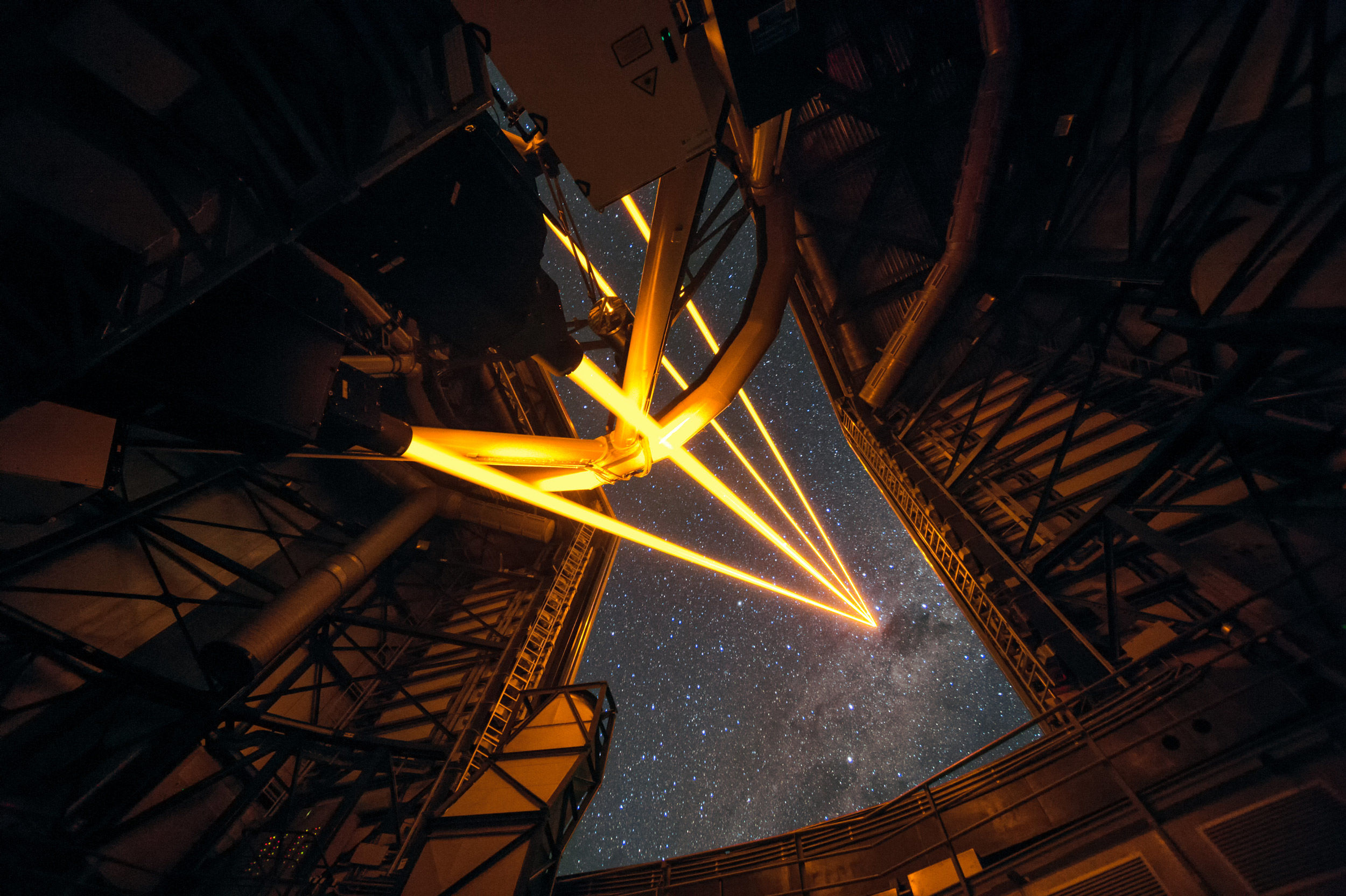Astronomers pew-pew their way to super-sharp images

Look, I'm not saying I hate air, but it does present certain problems.
The advantages are obvious. The ability to fly kites, appreciate clouds, watch pretty sunsets, and oh yeah, breathe, all have their roots in the existence of this ocean of air over our heads.
But for astronomers, it's something of a problem. One of the biggest issues we have with air is that it moves. Little packets of air kilometers above the ground swish to and fro, and that distorts our view of the heavens. These little packets act like lenses, bending the light from stars and other astronomical objects as it passes through. This causes the image to jump around, blurring out details in the telescope (and causing stars to twinkle). For historical reasons (and sometimes, I swear just to confuse people) astronomers call this condition seeing, and when you say "the seeing is bad" you mean that things are so bubbly up there that observations are compromised.
Launching telescopes above our air gets around this issue, but that's expensive and difficult. It turns out there's a much cheaper solution, and it works pretty well. If you can very rapidly measure just how a star in your telescope's field of view is dancing around, you can use that information to improve the situation. The usual method is to use a very thin secondary mirror (a mirror above the big primary one that gathers light, used to reflect the light back down to the detectors) with tiny actuators behind it. These apply pressure selectively to different parts of the mirror, deforming it in a very specific way such that it compensates for the movement of the air. When properly done, this adaptive optics (or AO) technique can do wonders.
We've had good AO systems for years, but a new kind has been built for the Very Large Telescope in Chile, and the results are astonishing. See for yourself:
Yegads. The image on the left is the planet Neptune without AO, and the one on middle is when it's turned on. Suddenly that blurry mess becomes sharp, and you can even see clouds in Neptune's atmosphere! It even compares well with Hubble's view (on the right, taken at a different time but with similar features).
The new system uses lasers to clean up atmospheric blur. The idea is to shoot a laser beam tuned to a very specific color into the sky. This particular color of light (a narrow slice of orange) is easily absorbed by sodium atoms, which respond by glowing fiercely. Seen from the ground, looking along the beam, these atoms are all in the same spot in the sky, creating an artificial star. In general AO needs bright stars to measure atmospheric seeing, but those are rare and unlikely to be in your field of view. The laser gets around that by creating a star wherever you need one.
This technique has been around a while too. The new bit is that multiple lasers are used to probe different layers of the atmosphere where the seeing may be different. The different artificial stars can then be measured separately and their effects added together, creating a more complete map of the seeing.
This technique — called laser tomography — works amazingly well. It does have a couple of disadvantages. For one thing, these lasers ain't cheap, so the process costs a bit of money (though far less than launching a 'scope into space). It tends to work better on bigger telescopes (with mirrors wider than 5 meters) than smaller ones. And it only works on a narrow field in the sky, so you can't use it to look at big objects.
But if you want to zero in on one small section of something, the results are fantastic. Check out how it improves the view of a globular cluster:
On the left is the whole cluster, viewed without AO. The middle is a zoom of the cluster core. On the right is that same view with the laser tomography switched on. You can see individual stars far more easily, and fainter ones too. Faint stars get blurred into invisibility without AO because their light gets spread out, making them even fainter; with AO you can collect that light and focus it into a smaller point, making it more easily visible.
The advantages of this are legion. For the cluster, seeing more and fainter stars means being able to see the stellar population more completely; lower mass stars are fainter and blurred out otherwise. Also, measuring the brightnesses of the stars is far simpler if they don't all overlap one another.
In general it's always better to see fainter things, and to be able to separate closely spaced objects. That's really the main purpose of telescopes in the first place! So this technique makes things even better.
Hopefully, too, as time goes on this will become cheaper, simpler, and more readily available to other 'scopes. And them based on this, even newer and better ways to improve observations will be found. That's the way things have gone for quite a while, and we humans are clever. I expect that trend to continue for a long, long time.





























